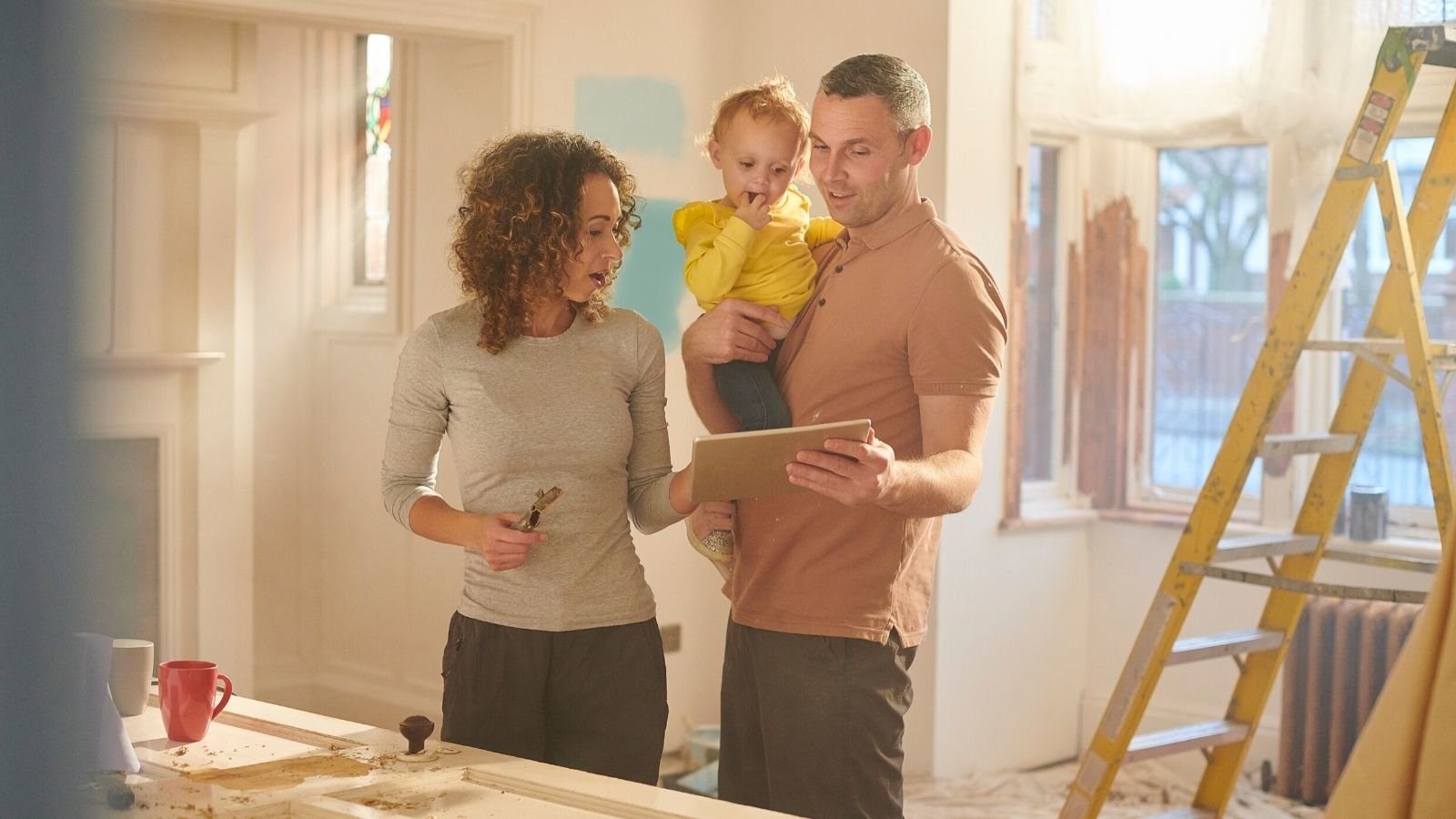4 Tips For Budgeting a Home Renovation

Renovations, especially when preparing your home for sale, can make or break how quickly your property will stay on the market. It’s easy to get caught up in the excitement of choosing new finishes for home projects or be blindsided by unforeseen hiccups that can dramatically increase costs. Deciding on how much to spend on home improvement projects can be tricky—lucky for you, I have compiled some tips that will help you stay on track and minimize any unwanted surprises!
Set Your Spending Limit
According to Zillow, you should spend no more for each room than the percentage of what that room values in the overall house value. For example, the kitchen generally makes up to 15% of the overall property value. If your home is worth $200,000, you will want to cap remodelling expenses at $30,000.
Another good guideline is not spending more than 10-15% of your home’s value on a single room. Any more than that will not proportionally add to the value of the home. HomeAdvisor states the average cost to renovate a kitchen at $4,000 – $60,000, a bathroom at $2,500 – $25,000, and a basement at $11,000 – $30,000. Keep in mind that older homes will often cost more to renovate if wiring and plumbing aren’t up to code.
You will also need to determine how you are financing your project! Your renovation budget will need to fit within the limit of available funds, whether it is by cash, loan or credit.
Prepare for Hidden Costs
This tip is possibly the most important of them all, so listen closely. Once you have concluded how much you can afford to spend, set aside 10-20% of your available funds for any unexpected expenses that may arise. You might have heard of the phrase, “things happen,” and it definitely applies to home renovations. Things go wrong or cost more than what was initially predicted, and by setting aside these funds at the beginning, you know that you will still have enough cash to cover no matter what happens.
Prioritize & Make a Plan
So long as there is no expertise required, consider doing some tasks yourself to help reduce labour costs. Things like pulling up tile, removing old cabinets, ordering your own fixtures and finishes, shopping for used or refurbished items, and doing your own painting are all easy to do yourself.
You’ve used all these tips and added value to your home, so now what? You don’t want to risk pricing too high in risk of not selling. Contact your favourite local REALTOR® for a free home evaluation!
Top Home Decor Design Trends for 2021

Home design trends are constantly changing, but with the state of the world over the past year and a half, we can identify some common themes emerging. We see many rethinking the functionality of their homes and the concentration on building a safe, calm, and joyful space to centre us in throughout the various recent and tumultuous events. Here are some key trends that you can easily incorporate into your living space or make it more appealing to potential buyers if you are planning to sell your home!
Say Goodbye to Exclusively Formal Rooms
Have a formal dining room or living room you only use once every 6 months? The focus is now on livable luxury and versatility in design. This means rethinking our less-used spaces and embracing furniture concepts that play double duty—we’ve seen many formal dining rooms turn into home offices and school rooms. However, this is also your sign to turn that space into something totally your own that sparks joy. Always wanted a craft room? Maybe a library to live out your Beauty & the Beast dreams? Go for it!
Embrace Natural Materials
This is the return of nature and earthy inspiration to really become one with that zen mindset. Pieces like cream coloured ceramics, marble coffee tables, wicker baskets, rattan headboards, and unfinished wooden furniture help create a comforting and organic look and feel. Earthy tones and warm, soothing colour palettes like wine reds, sagey greens, and golden yellows have also increased popularity.

Become a Plant Parent
Speaking of natural, 2020 was back to basics. Hands up if it was your mission to successfully make a loaf of delicious sourdough bread and adopt a few plant babies! Yeah, I see you, Saskatoon. We’re definitely seeing this continuing the trend through 2021.
Incorporating plants into your décor honestly does wonders to help refresh the air and brighten your mood. Easy-to-care-for plants and textured pots work like magic to bring some life to a space, and edible gardens are perfect for a sunny kitchen window sill.
Maximize Natural Sunlight
Be aware of the lack of Vitamin D from being cooped up indoors—sunlight is scientifically essential to our happiness. Yes, really! And studies have shown that it can actually have a direct effect on a homebuyer’s first impression of the home, especially when staging to sell.
With the goal of calm and centred living space, gone are heavy window dressings. Instead, try a semi-opaque cotton curtain with some tassel trim for a subtle texture.

Solid Statement Walls? Forget About It
Wallpaper is not just for your grandmother anymore. It has officially made a comeback! Add some personality to your space with a statement wall, or use it to line your cabinets or shelving. Want a less permanent option in case you are renting and planning to buy a home? Peel and stick wallpaper is an exceptional way to play with your space without the commitment.
More is More
Granny Chic has a nice ring to it, right? The year 2021 has marked the rise of the “grandmillennial” trend, described as a revival of the homey design elements that you may find at your grandparent’s house. This includes velvets, floral wallpaper, brass, delicate china, antique paintings, and other vintage touches. And don’t be afraid to mix patterns, either.
This style can evoke a sense of tradition, comfort, and nostalgia. Combining old-world elements (antique paintings) and the new world comforts (modern lighting fixtures) can also create a perfect timeless mix.
No matter what your home ownership goals may be this fall, whether it’s buying a new house or selling your existing one, keep these top design trends in mind for either. From dolling up your new digs or staging for selling success, these simple changes can keep your home looking modern, chic, and effortless!
While Your Home is Listed

Things to Know While Your House is For Sale
Now that your home is for sale, what do you do in the meantime? Here’s a list of a few points to remember and take note of so you’re not feeling helpless throughout the process.
Be Flexible
Be as flexible as possible with showing times. Make it easy for buyers to come and view your home so you don’t miss out on a potential sale. I realize that there are circumstances when this doesn’t allow but being as flexible as you can without too much of an inconvenience to your schedule will have it’s benefits.
Open Houses
I leave the decision of whether or not to do an open house up to my sellers. I’ve found that in some instances, an open house was useful and resulted in a success. However, more times than not, an open house hasn’t resulted in anything other than the neighbours coming over to visit. I leave that decision entirely up to you.
Be Reachable
I will need to contact you for showings and any offers we get and I will need to be able to get ahold of you on short notice. If you are going away, I’ll also need to know that.
Keep Clean
Try to keep your house as clean as possible during times of showings and open houses. We want to eliminate the objections a potential buyer might have and if your house shows great, then it’ll be that more attractive to buyers.
Updates
Throughout the time when your house is for sale, I will send you weekly updates in regards to the number of viewings your home has had on certain websites as well as any new comparable houses for sale and ones that have just sold. This will help keep you informed about the market in your area and help you make an informed decision about price reductions. I will also follow up with agents when a showing has occurred and what the feedback has been so you know what, if any, improvements can be made on your part.
These few things will help you reach your goal of selling your home for the most money and in the least amount of time.
Preparing Your Home for Sale

Things You Should Consider
So you’re ready to put your house up for sale. What should you do to make it more sale-able, attract more buyers, and more importantly get more money in your pocket? Here’s a list of things to consider before putting your house on the market.
Renovations
I don’t recommend doing any major renovations just to sell your home but if you are willing to do the work (or can get it done inexpensively) then consider smaller renovations like adding a backsplash, fresh paint on the walls, and landscaping to add more curb appeal. These will go a long way for potential buyers.
Clean
The power of a clean house is strong, I highly recommend giving the inside a thorough cleaning before allowing potential buyers through your door. Steam clean the carpets, wash floors, and dust. Don’t forget about the exterior. Sweep, rake, or shovel as needed, clean up yard debris, and make the exterior an attractive place that buyers want to be.
Pack
You’re moving anyways so you might as well start packing. De-clutter your home, room by room, and pack away things you don’t think you’ll need before you move. You can take down personal items like pictures if you wish but as long as it’s a reasonable amount then buyers won’t have a difficult time envisioning themselves in your home. Remove as much as you can from the kitchen counters and on the fridge doors. I recommend packing until your house feels empty but isn’t literally. That’s when you know when to stop.
Gathering Items
Before I list your home I will require a few items to make the transaction as seamless as possible. I’ll need contact information of your financial institution to send documents to once the sale is complete, a spare set of keys for the lockbox, your surveyor’s certificate for the property, and any other pertinent information required for your home.
These tips will ensure your house will be as presentable as possible and increase it’s sale-ability when it counts the most.
What Are the Costs of Selling?

You already understand the importance of hiring a REALTOR®, but what are the fees that you will incur? As a seller you don’t pay for any inspections requested by the buyer or a land titles transfer fee but there are a few costs that you will encounter.
Commissions
This is the big one. As a seller you pay both the buying and selling agent’s commissions. When you purchase a home, you won’t have this cost. This will come out of your proceeds at the end from the lawyer. Commissions are typically a percentage of the sale price of the home and most often you will see a percentage that looks like 6/4/2. This means that the commission is 6% of the 1st $100,000, 4% of the 2nd $100,000, and 2% of any remaining balance. I also can offer a flat fee commission. I find that helps with those who are sticking to a strict budget and need to know the amount they will be paying upfront. Remember, I only get paid if your house sells.
Legal
There are also legal fees associated with the sale of your home. Although it’s less than if you were purchasing, they will cost you usually between $700-$800 + GST + PST
Penalties
There may be a payout penalty on your mortgage if you are planning on selling and paying out the mortgage before your term is up. The penalty is usually 3 months of interest or the interest differential with your rate and what the current rate- whichever is higher. If your mortgage has a portability clause and you are planning on buying something after you sell, that is a great way to avoid the penalty altogether.
Miscellaneous
If you are planning on hiring cleaners to do a deep clean pre-sale, hiring a carpet cleaner, or hiring someone to do repairs, these will all have to be accounted for in the budget.
These costs and fees may seem like a lot of money but they are designed to ensure that you will achieve the most money once your house does sell and some are unavoidable. It’s better to know up front what these costs will be and will make budgeting for the new house that much easier.

 Facebook
Facebook
 Twitter
Twitter
 Pinterest
Pinterest
 Copy Link
Copy Link

